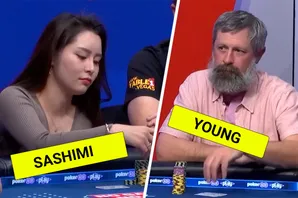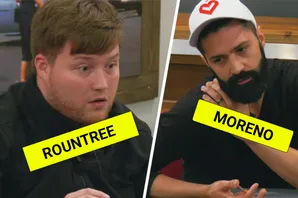Whether you prefer to play poker in live games or prefer online poker, you’re going to encounter a few different types of forced bets. One of those forced bets is the small blind.
Read on to learn everything you need to know about small blinds, how and when to play them, and important strategies to keep in mind during your next game.
The small blind defined
The small blind is a mandatory bet that the first player to the left of the dealer button plays before seeing their cards. The small blind is one of two mandatory bets played before the start of the game. The other is the big blind, which is played by the player two seats to the left of the dealer.
In most poker games, the small blind is valued as half of the minimum bet for the poker table, but each casino or poker tournament reserves the right to set the value of all minimum bets and blinds.
In a heads-up game (a poker game with only two players), the player with the dealer button also contributes the small blind. The other player contributes the big blind.
Texas Hold’em, Omaha, 5-Card Draw, and many other poker variation card games all use small blinds and big blinds.
What is the point of the small blind?
The main point of blind bets, like the small blind and big blind, is to add value to the starting pot and incentivize other poker players to play their starting hands.
Players contribute to blinds the first betting round, which means the starting pot contains enough chips to entice players into seeing their cards and trying to build a good hand.
While forced bets may seem unfair to beginner players, it's important to remember that the players required to place the small blind and big blind will rotate in each hand so everyone has a responsibility to contribute to the pot.
What is the difference between the small blind and the big blind?
There are two main differences between the two blind positions in poker games.
Size of the bet
The first difference is the value or size of the bet. The big blind is usually equivalent to the table’s minimum bet, while the small blind’s value is half the minimum bet.
Physical position
The second difference between these common blinds is physical position. The small blind position is the player to the left of the button, while the big blind position is the player to the left of the small blind (or two seats to the left of the button).
No matter which variant of poker you play, the main similarity between the small blind and the big blind is that they’re required to contribute to the pot prior to seeing their hole cards. All other players get to see their starting poker hand before deciding whether or not to place a bet.
How do you play the small blind in poker?
If you’re new to poker strategy, it’s important to refresh yourself on key poker rules like how to play the blinds before a game. The last thing you want is to seem like you don’t know what’s going on!
Playing the small blind is pretty simple. If you’re seated to the left of the dealer, you contribute half the minimum bet at the start of the game before any cards are dealt.
If half of the minimum bet is an odd value (like $1.50), then most tables allow the small blind to round down to the next whole number.
When should you call the small blind?
After blind bets are placed and the hole cards are dealt, the player to the left of the big blind position can either call the big blind, raise, or fold depending on the quality of their cards. Each player will have to choose whether to call, raise, or fold.
Eventually the small blind must decide if they want to forfeit their blind bet by folding, or call to match the big blind or raised bet.
While it’s unfortunate to lose your small blind, pay attention to how enthusiastic the other players seem. If several players fold, it may make sense to call, but if your hand isn’t inspiring confidence, then you may want to cut your losses.
What happens when the small blind goes out?
If everyone else in the game folds post flop and you fold as the small blind, then the big blind gets back their initial bet and yours. You lost half the minimum bet for the game, and the big blind has earned half the minimum bet for free.
If you fold as the small blind at the end of the first round of betting, you show the other players that you don’t bet frivolously. It wouldn’t have cost you very much to stay in the game, but you chose to bow out. In future hands, other players will pay attention to how you bet and they’ll be less likely to assume you’re bluffing.
Common small blind mistakes
There are a few common mistakes that many new poker players make when playing the small blind. Here’s how to avoid losing too much money in this hard to play position.
Accept your fate
The small blind is usually a losing position. Unless you start the game with a premium hand like a pocket pair of aces, you’re likely to be at a disadvantage. Set your expectations accordingly. Approach the small blind with the goal of losing as few chips as you can. You’ll be in a better position in future rounds and someone else will be stuck with the small blind position.
Avoid calling raises
It’s one thing to call up to the size of the big blind when you know you have a weaker hand. It’s another situation entirely to call on other players’ raises if your hole cards aren’t good. Avoid calling raises to avoid losing big bucks!
Small blind strategy
Instead of viewing the small blind as a necessary evil, you can harness this unpopular position to your advantage.
Every other player may have a chance to see how you act before choosing their own strategy for each betting round, but you can minimize your losses and maybe even benefit in a few key ways as long as you enter into the small blind position with a planned strategy.
Stealing, avoiding donk bets, watching other players' reactions to gauge their cards, and employing a 3-bet strategy can help you turn the small blind into a more profitable position.
Know when to steal
If all the other players fold, you have an opportunity to steal the pot from the big blind instead of folding. While many players assume you would only steal if you have a bad hand, it’s better to steal with a good hand.
Instead of just calling the big blind, you can actually raise and challenge the big blind for the pot.
While this is a good opportunity to make a small profit, the other players will take you less seriously if they find you’re bluffing in your steal attempt. Steal sparingly with a bad hand or they’ll always assume you’re bluffing.
3-bet strategies
If the big blind is the first bet and the pre-flop raise is the second bet, then the 3-bet is the third bet, or second raise of the game. For example, if the big blind was $2, the pre-flop raise brought the bet to $4, the 3-bet would be $6.
If you only make a 3-bet with very strong cards, other players will tend to fold as a result and the pot will stay relatively small.
Instead, consider making a 3-bet with a good, if not strong, hand most of the time, and occasionally with a weaker hand to drive up the pot value and keep other players from being afraid of your raises.
Keep your eye on the big blind
Each player will behave differently depending on their position in the game. The small blind is at the biggest disadvantage, but the big blind and the Under the Gun position (the next player to the left) are also in less-than-ideal positions.
Late position players, like the dealer and the players to their right, have the greatest advantage because they can watch the other players’ behavior.
As the small blind, you should pay attention to the late positions, but if the whole table folds, the big blind is your main opponent. Keep an eye on them during each round when deciding on your betting strategy.
Don’t donk bet
A donk bet is a bet made by a player out of the betting order. For example, if the small blind raises immediately after the flop, that would be considered a donk bet.
Donk bets are usually a bad idea because you lose the opportunity to see how the other players behave as the game progresses while also giving other players more information about your hand.
More advanced players can use donk betting strategically, but until you have a firm grasp on the expected value of your cards and the potential hands of your opponents, you should avoid this somewhat risky technique.
The takeaway
Every poker player has to be the small blind at some point. Now that we’ve covered the limitations and potential strategies associated with this often-maligned position, consider viewing it as an opportunity to minimize losses and potentially set up some gains.
By paying close attention to your opponents, making smart decisions about calls and raises, and folding your hand strategically, you can establish yourself as a worthy opponent for future hands when you have a more advantageous position at the poker table.Continue to familiarize yourself with the various ins and outs of forced betting, playing as the big blind, and explore more advanced strategies for Texas Hold’em and other variants on your journey to becoming an expert poker player.
What is the small blind in poker FAQs
What is the big blind and small blind?
There are two blinds in poker – the small blind and the big blind. Typically speaking, the big blind is the minimum bet for the game to proceed, while the small blind is usually half the big blind. Both are required for a game to get going and are essentially automatic bets before any calling or raising of the stakes can take place.
Who pays the big blind and small blind?
In poker, two players must pay the small and big blind before any cards are dealt. The blinds rotate one place to the left after each hand so that everyone takes their turn paying. You can regard each bet as automatic and necessary for the cards to be dealt. Without the small and big blinds, the game cannot be played.
Is the big blind allowed to raise?
The player who pays the big blind is permitted to raise in pre-flop betting. However, they are also permitted if other players before them have only called the big blind.
What is the purpose of poker blinds in cash games and tournaments?
In cash games and tournaments, blinds exist to ensure that every hand has a minimum amount of money in the pot. After all, if blinds weren’t necessary, the game could get going without any chips in the pot and players could simply check all the way through to the end.
Featured image source: Flickr by Poker Photos used under CC license




























